The Cultural Significance of Attire: A Colorful Expression of Identity
The Cultural Significance of Attire: A Colorful Expression of Identity
Attire plays a critical role in shaping cultural identity across the globe. The clothing we wear not only provides functional benefits but also serves as a profound expression of our heritage, beliefs, and social status. This article delves into the cultural significance of attire and examines how clothing varies between different regions, gender identities, and social groups. By understanding these cultural nuances, we can appreciate the rich tapestry that attire weaves into the fabric of society.
Understanding Cultural Significance
Cultural significance refers to the importance attributed to certain elements of culture, including attire. Clothing can symbolize a multitude of aspects such as tradition, spirituality, and historical context. The garments we choose are often dictated by various factors: environmental conditions, societal expectations, and personal choice.
Historical Context of Attire
Throughout history, attire has evolved, often reflecting the society's values and beliefs. Various civilizations developed unique styles of clothing that were influenced by geography, available materials, and cultural exchanges. For example, traditional Japanese kimono fabrics are often imbued with symbolic meanings associated with seasons and nature, demonstrating the deep connection between attire and cultural beliefs.
Regional Variations in Attire
Different cultures across the globe showcase their distinct identities through attire. Below is an overview of some traditional outfits from various regions:
| Region | Traditional Attire | Significance |
| India | Sari and Dhoti | Symbol of cultural heritage and regional diversity |
| Scotland | Kilt | Represents Scottish nationality and clan identity |
| Myanmar | Longyi | A garment representing tradition and social norms |
Gender and Attire
The relationship between gender and attire is another critical area that reflects cultural significance. In many societies, clothing can express gender roles, influencing how individuals perceive themselves and are perceived by others. Men and women often wear distinctly different types of clothing, and these garments are laden with social expectations.
In many cultures, the concept of gender-neutral attire is gaining traction, challenging traditional norms. For instance, young fashion designers highlight the importance of sustainable fashion by creating unisex clothing lines that promote individual expression and social acceptance.
The Role of Attire in Festivals and Celebrations
Festivals often provide a vibrant platform for cultural expression through attire. Traditional clothing worn during celebrations often reflects the history and values of a community. For example, during the Chinese New Year, individuals don vibrant qipaos and tang suits, which symbolize luck and prosperity for the coming year.

In African cultures, traditional attire plays an essential role during ceremonies such as weddings and rites of passage. Each garment carries specific meanings, representing aspects of ancestry, community, and spirituality.
Modern Influences on Attire
The globalization of fashion has introduced new elements to traditional attire, leading to a fusion of styles. This blending can create a beautiful tapestry of culture, where contemporary designs honor historical significance. The rise of social media platforms has also facilitated the spread of various attire styles, fostering a new culture of inclusiveness and diversity.
Attire and Identity
The clothing we wear significantly impacts our sense of self. It acts as an extension of our identity—communicating information about our cultural background, beliefs, and personal style. Furthermore, attire has the power to challenge stereotypes and promote inclusion. The fashion industry has begun to embrace this notion, creating campaigns that represent diverse communities and foster acceptance.
Embracing Mental Health Through Attire
Beyond just cultural significance, attire can have profound effects on mental health. Wearing outfits that resonate with our identity can boost confidence and self-esteem. Studies have shown that when individuals dress in a way that aligns with their personal style, they often feel more empowered and happy. This phenomenon is often referred to as “enclothed cognition,” signifying how clothing influences both the wearer’s psyche and behavior.
Conclusion and Recommendations
In summary, the cultural significance of attire transcends mere fabric and stitching; it embodies the very essence of identity, tradition, and values. Understanding the diverse meanings behind different types of clothing allows us to appreciate cultural richness while promoting respect and inclusion.
As we navigate our personal styles, consider the cultural implications of your attire choices. Support ethical fashion initiatives that reflect cultural appreciation rather than appropriation, fostering a world where individual expression can thrive within a framework of cultural respect.
In conclusion, keep in mind the following suggestions related to attire: always engage with fashion mindfully, celebrate cultural diversity, and recognize the power that attire possesses in shaping individual and collective identities. By doing so, we can contribute to a more inclusive society where everyone’s cultural stories are honored through the garments they wear.
